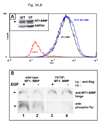Epidermal growth factor receptor-mediated membrane type 1 matrix metalloproteinase endocytosis regulates the transition between invasive versus expansive growth of ovarian carcinoma cells in three-dimensional collagen
- PMID: 19509114
- PMCID: PMC2843416
- DOI: 10.1158/1541-7786.MCR-08-0571
Epidermal growth factor receptor-mediated membrane type 1 matrix metalloproteinase endocytosis regulates the transition between invasive versus expansive growth of ovarian carcinoma cells in three-dimensional collagen
Abstract
The epidermal growth factor receptor (EGFR) is overexpressed in ovarian carcinomas and promotes cellular responses that contribute to ovarian cancer pathobiology. In addition to modulation of mitogenic and motogenic behavior, emerging data identify EGFR activation as a novel mechanism for rapid modification of the cell surface proteome. The transmembrane collagenase membrane type 1 matrix metalloproteinase (MT1-MMP, MMP-14) is a major contributor to pericelluar proteolysis in the ovarian carcinoma microenvironment and is subjected to extensive posttranslational regulation. In the present study, the contribution of EGFR activation to control of MT1-MMP cell surface dynamics was investigated. Unstimulated ovarian cancer cells display caveolar colocalization of EGFR and MT1-MMP, whereas EGFR activation prompts internalization via distinct endocytic pathways. EGF treatment results in phosphorylation of the MT1-MMP cytoplasmic tail, and cells expressing a tyrosine mutated form of MT1-MMP (MT1-MMP-Y(573)F) exhibit defective MT1-MMP internalization. As a result of sustained cell surface MT1-MMP activity, a phenotypic epithelial-mesenchymal transition is observed, characterized by enhanced migration and collagen invasion, whereas growth within three-dimensional collagen gels is inhibited. These data support an EGFR-dependent mechanism for regulation of the transition between invasive and expansive growth of ovarian carcinoma cells via modulation of MT1-MMP cell surface dynamics.
Figures











References
-
- Carpenter G, Cohen S. Epidermal growth factor. J. Biol. Chem. 1998;265:7709–7712. - PubMed
-
- Wells A. EGF receptor. Int J. Biochem. Cell Bio. 1999;31:637–643. - PubMed
-
- Yarden Y, Sliwkowski MX. Untangling the ErbB signaling network. Nat. Rev. Mol. Cell. Biol. 2001;2:127–137. - PubMed
-
- Lafky JM, Wilken JA, Baron AT, Maihle NJ. Clinical implications of the ErbB/epidermal growth factor (EGF) receptor family and its ligands in ovarian cancer. Biochimica et Biophysica Acta. 2008;1785:232–265. - PubMed
-
- Jorissen RN, Walker F, Pouli N, Garrett T, Ward C, Burgess A. Epidermal growth factor receptor: mechanisms of activation and signaling. Exp. Cell Res. 2003;284:31–53. - PubMed
Publication types
MeSH terms
Substances
Grants and funding
LinkOut - more resources
Full Text Sources
Medical
Molecular Biology Databases
Research Materials
Miscellaneous

